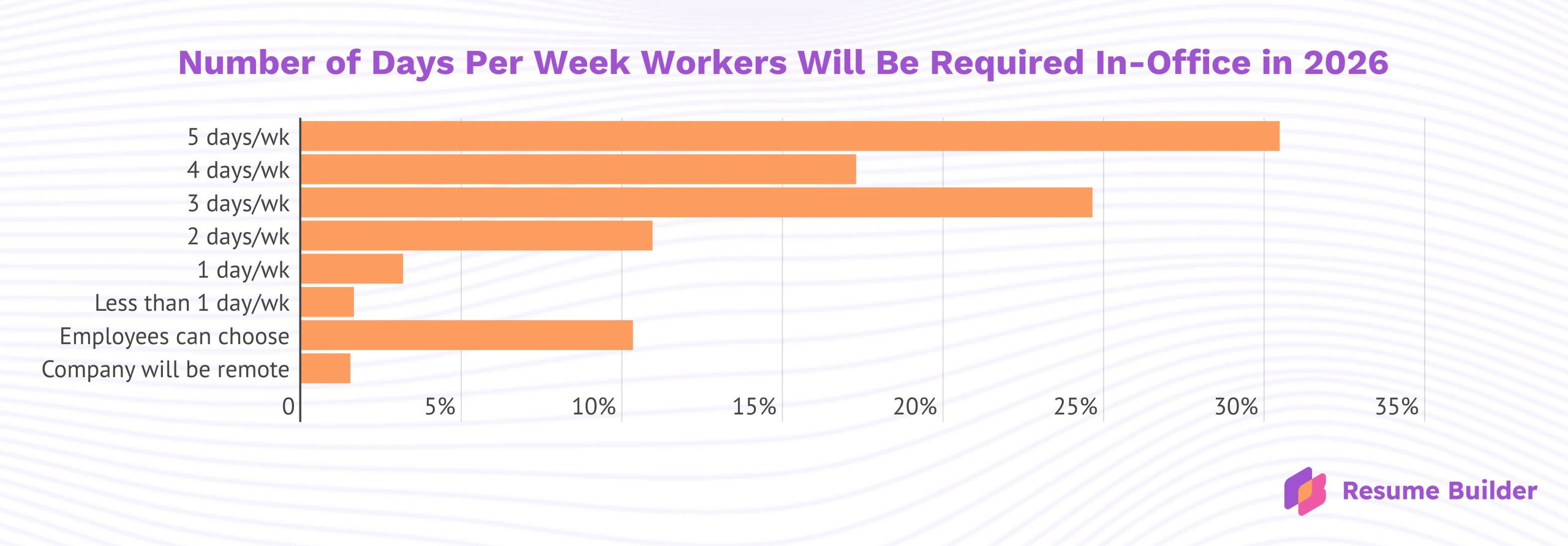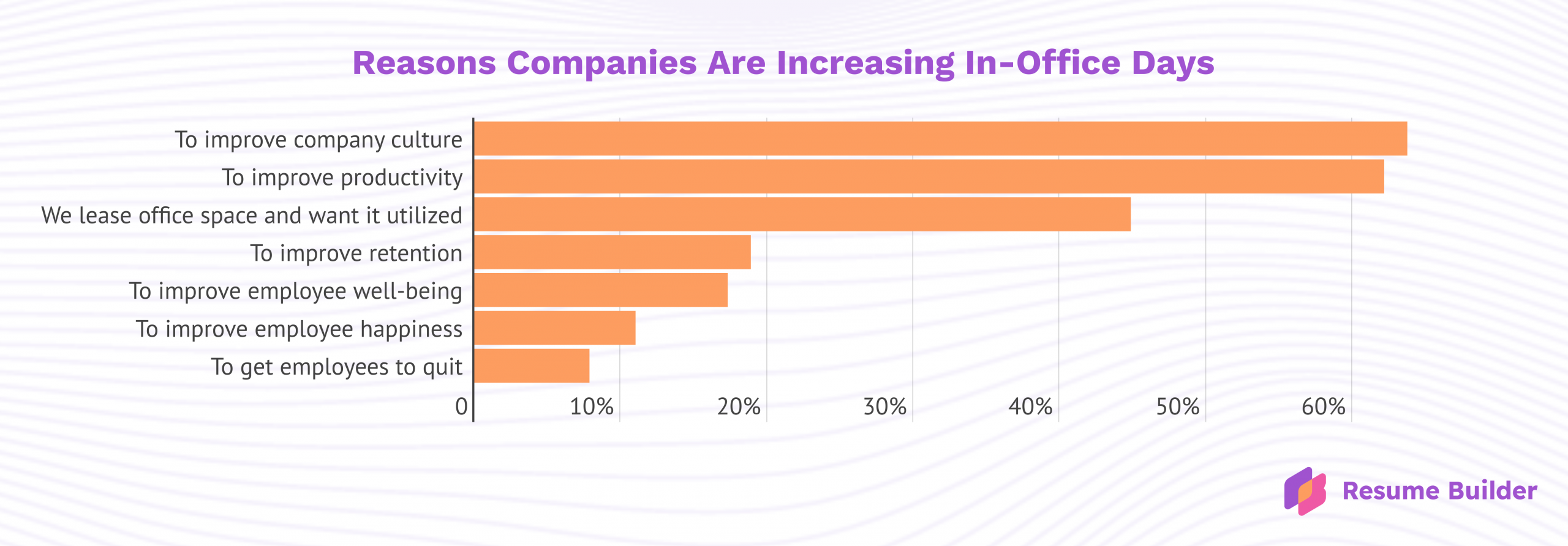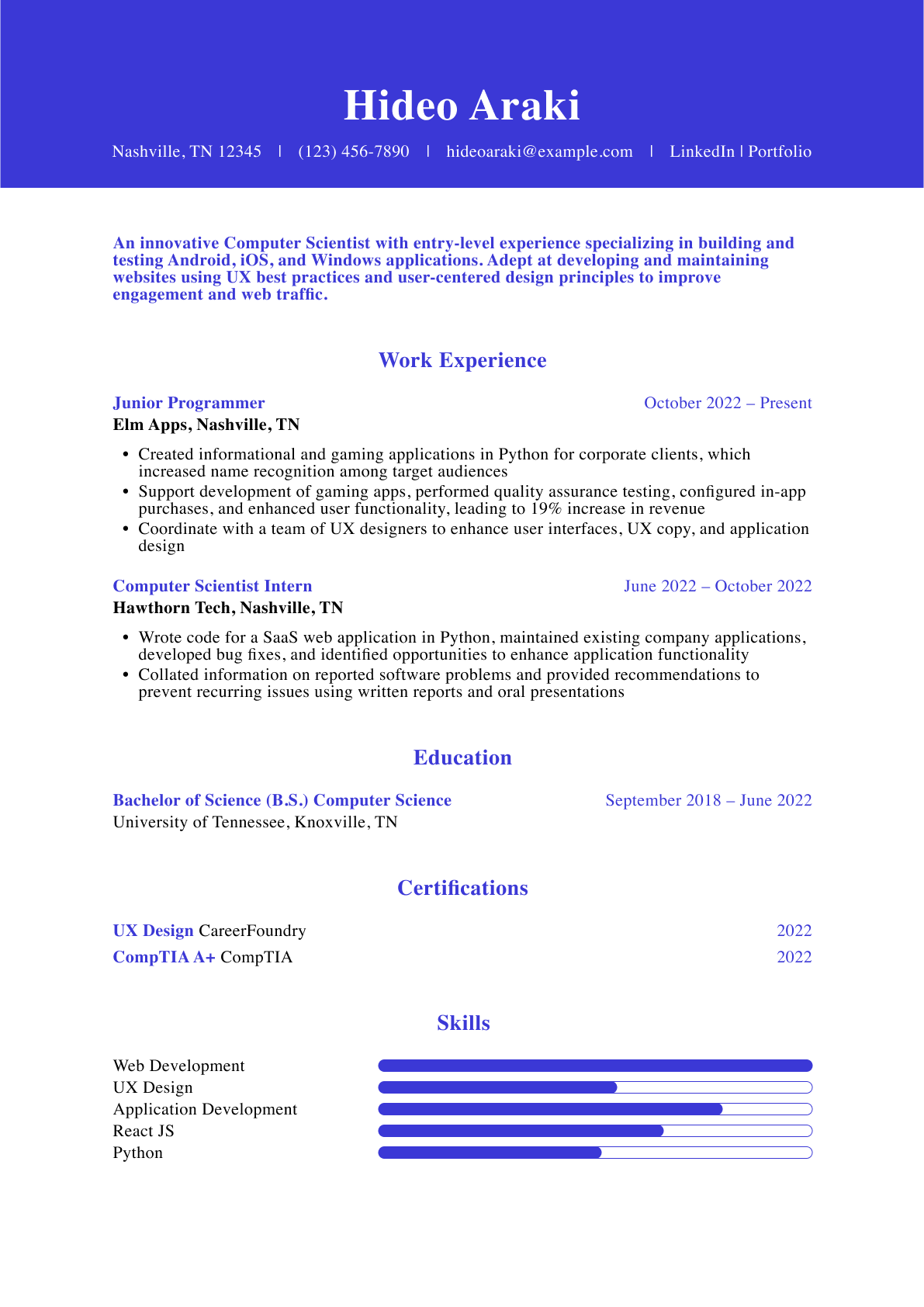An October survey by ResumeBuilder.com of 978 business leaders finds that companies will continue to have employees work from the office. While hybrid work remains the norm, more companies plan to increase required in-office days in 2026, with many aiming for full-time office attendance.
Key findings:
- Nearly half of companies will require employees to be in the office at least four days a week in 2026
- 1 in 8 companies are increasing the number of required days in the office in 2026
- Companies that plan to increase office days are doing so to improve productivity and company culture
- 3 in 10 companies won’t allow for remote work
- Most companies don’t provide incentives for employees to work from the office
3 in 10 Companies Will Have Workers In-Office 5 Days a Week in 2026
Most companies currently operate on a hybrid schedule, while fully remote work has become rare. In 2025, 28% of companies require employees to be in the office five days a week, 13% require four, and 28% require three. Only 11% allow employees to choose fully remote work, and just 1% are fully remote.
By 2026, the trend continues toward more in-person work. Five-day requirements rise to 30%, four-day schedules climb to 17%, and three-day setups drop slightly to 25%. The share of companies allowing employees to choose fully remote work declines to 10%, while those operating fully remotely remain at just 2%.

Most business leaders still believe hybrid work is the best model, even as their companies move in the opposite direction. While 28% of companies currently require employees to be in the office five days a week, only 16% of leaders think that should be the standard. The majority say three days per week is ideal (27%), followed by two days (19%) and four days (13%).
“Many leaders claim to support hybrid work but are calling employees back more often because of underlying pressures and old habits,” says Stacie Haller, Chief Career Advisor at ResumeBuilder.com. “They equate visibility with productivity and fear losing culture and collaboration.”
“Executives still say ‘hybrid,’ but often mean structured office days rather than true flexibility,” she adds. “The result is a widening gap between leadership intent and employee expectations that’s reshaping workplace trust.”
1 in 8 Companies Will Increase Days Required In-Office in 2026
Overall, 13% of companies will increase required in-office days next year, while only 5% plan to reduce them, signaling a continued shift toward stricter RTO policies.
“If hiring slows or layoffs rise in 2026, strict RTO policies may clash with broader labor market trends,” says Haller. “Employees may comply short-term, but resentment and turnover will rise once the market rebounds.”
Company culture and productivity motivate companies to increase days in office
The leading motivations for reducing required in-office days include improving employee happiness (55%), well-being (53%), and retention (49%).
In contrast, companies increasing the required in-office days are doing so mainly to strengthen company culture (64%), improve productivity (62%), and maximize use of office space (45%). Notably, 8% admit they are doing it to push employees to quit.

Additionally, 38% of companies increasing in-office days say they will definitely or probably expand office space in 2026, indicating this trend is backed by long-term commitments.
“Research shows that increasing office attendance does not automatically improve productivity or culture; those assumptions are largely outdated post-pandemic,” says Haller. “Culture thrives not from proximity but from intentional communication, inclusion, and trust. Forcing more office days can erode engagement and morale, especially if employees see no clear benefit. The most successful hybrid models focus on purposeful presence, bringing people together for collaboration, creativity, and connection. In today’s workforce, autonomy and meaningful interaction drive culture more than physical attendance.”
Less Than One-Third of Companies Incentivize Employees To Come to the Office
Despite this push, incentives to make the office more appealing are limited. Only 28% of companies offer any incentives at all to get employees to return to the office. Among those that do, the most common are social events (55%), catered meals (51%), and commuter benefits (51%), while fewer offer raises (34%) or child care benefits (30%).
Methodology
This survey, commissioned by ResumeBuilder.com, was conducted online via the polling platform Pollfish in October 2025. A total of 978 business leaders completed the survey. To qualify, respondents were required to be at least 29 years old, have a household income of $75,000 or higher, hold a bachelor’s degree or higher, and occupy a manager-level or more senior role at a company with more than 10 employees. Participants also had to indicate that their company transitioned to a remote model during the height of the COVID-19 pandemic.
For all media inquiries, contact [email protected].
